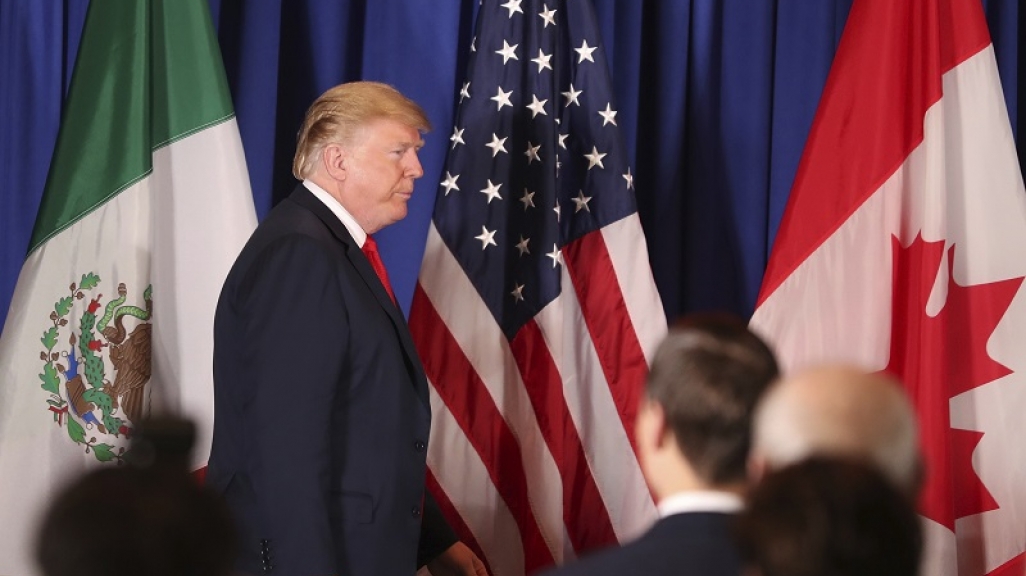AS/COA Insider: Eric Farnsworth on Where the USMCA Stands
AS/COA Insider: Eric Farnsworth on Where the USMCA Stands
A year after NAFTA 2.0 negotiations ended and with the U.S. election around the corner, “The legislative days are ticking away,” says AS/COA’s vice president.
At the end of November 2018—and after months of negotiations—North American leaders inked the U.S.-Mexico-Canada Agreement, often dubbed “NAFTA 2.0.” But the deal has yet to make its way through the U.S. Congress for ratification, raising questions about its fate as Washington readies for a presidential vote and Donald Trump seeks reelection.
Where does the deal, known as USMCA, stand and what is the role of each of the three member countries in advancing it? Eric Farnsworth, our vice president and head of COA’s Washington office, went over the state of play.
- Learn more about COA’s Trade Advisory Group
- Get North American trade numbers
- To speak with an expert on this topic, please contact mediarelations@as-coa.org.
AS/COA Online: It's been a year since USMCA negotiations ended. The leaders of the United States, Canada, and Mexico signed it ten months ago, but we’re still waiting for implementation. Where does the deal stand in terms of U.S. congressional ratification, and what happens if it doesn’t go through this fall?
Eric Farnsworth: The deal stands as being ratified by one country and pending ratification in two. Mexico ratified it relatively early on. The United States and Canada have yet to do so, but the issue, of course, is the United States. The real negotiation, some have said, is now ongoing between the White House and the Democratic-controlled House of Representatives. Without 218 votes in the House, the agreement itself can’t be passed. In order to get those 218 votes, there has to be some horse-trading about the text itself.
The problem is that a number of the things that are being discussed are highly politicized in and of themselves. And beyond that, we are in a hyper-politicized environment in Washington where Republicans and Democrats seem to not even want to talk to each other, much less come to agreement on something as significant as a strong trade agreement among Canada, the United States, and Mexico.
So, we are in a process here in Washington where negotiators are trying to get to “yes” in a difficult environment, and the window for doing such a thing is closing. There is nothing more political or difficult than to do real, hard negotiations during a presidential election cycle. Some have suggested that the time to move the USMCA through the House is now or, at the very latest, before the U.S. Thanksgiving holiday so that it can be ratified by the U.S. Senate and signed by the president before the U.S. presidential season kicks off in earnest in 2020.
AS/COA Online: As you mentioned, Canada also hasn’t ratified it yet. Why not?
Farnsworth: Canada is in a very interesting position. It’s in a highly political moment, given that its own elections will be October 21. Prime Minister Justin Trudeau is running for reelection and he’s facing some political difficulty right now.
But the real issue here for Canada is that the Canadian government does not want to ratify an agreement where they don’t know, at the end of the day, what they’re actually agreeing to. They’re waiting for the U.S. process to work itself out so they can evaluate what the Americans have come up with and say, “We can live with that” or “No, we can’t.” The Canadians are waiting for Washington to move first.
I would anticipate that relatively soon after the United States ratifies the agreement, if indeed we do that, Canada would take steps of its own to do the same.
AS/COA Online: Mexico is the only one of the three countries that has ratified the deal so far. What steps is the Mexican government taking to get its USMCA partners, notably the United States, to do the same?
Farnsworth: Mexico has learned a lot of lessons from the days of NAFTA ratification, as well as negotiations subsequent to that. Since USMCA was finalized, Mexico has been actively seeking to promote it in Washington. Not just with the administration, but certainly with the U.S. Congress, leaders in Congress, leaders outside of Washington at the governors’ level, and with the private sector. Mexican Ambassador Martha Bárcena has been out there selling the agreement in an appropriate and understated way. The Mexican private sector has been active. Obviously, the Council of the Americas has had a major role in a leading way to get the word out about the importance of this agreement. It is, at this point, an education campaign to show people what is in the agreement and why it’s important. That’s the first step.
The second step is substantive. In the agreement itself, Mexico came very far down the path to meeting the demands of the U.S. negotiators on areas like labor reforms, environmental protections, and all kinds of things that the United States had been requesting—or in some cases demanding—for years. The Mexican government under Andrés Manuel López Obrador has been forthcoming and said, “Yes, that is in Mexico’s own interest, and so we’re going to move forward on some of those issues.”
But the United States has said, “Well, it’s great to agree to those provisions in the agreement, but will you enforce them? And until you have a record of enforcement, Mexico, we don’t believe that you’re actually going to do it, so we’re not going to move this agreement forward in the U.S. Congress.”
That’s the conundrum: it’s a chicken-and-egg issue. Many Democrats on the Hill are talking about enforcement, and Mexico is saying, “Well, we’re not going to do these things until we actually have an agreement that in some ways compels us to go ahead and do it.”
I’m more persuaded by the Mexican argument: “Look, what you’ve asked for in Washington is in the agreement, so pass the agreement. Let’s enforce it and let’s move North America forward together.” Clearly, Mexico has advanced down the path of labor and environmental reforms and protections in a way that those of us who were involved in the original NAFTA negotiations back in 1992 and 1993 might not have ever predicted, so I think Mexico has come a long way in that regard.
This interview has been edited for length and clarity.









 USMCA Passage: The Win AMLO Needs in 2019
USMCA Passage: The Win AMLO Needs in 2019